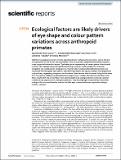Files in this item
Ecological factors are likely drivers of eye shape and colour pattern variations across anthropoid primates
Item metadata
| dc.contributor.author | Perea-García, Juan Olvido | |
| dc.contributor.author | Ramarajan, Kokulanantha | |
| dc.contributor.author | Kret, Mariska E. | |
| dc.contributor.author | Hobaiter, Catherine | |
| dc.contributor.author | Monteiro, Antónia | |
| dc.date.accessioned | 2022-10-28T11:30:04Z | |
| dc.date.available | 2022-10-28T11:30:04Z | |
| dc.date.issued | 2022-10-15 | |
| dc.identifier | 281907169 | |
| dc.identifier | 5cdea3f6-ee52-4141-937d-1252be58fc9d | |
| dc.identifier | 85139886426 | |
| dc.identifier | 000869292100005 | |
| dc.identifier.citation | Perea-García , J O , Ramarajan , K , Kret , M E , Hobaiter , C & Monteiro , A 2022 , ' Ecological factors are likely drivers of eye shape and colour pattern variations across anthropoid primates ' , Scientific Reports , vol. 12 , 17240 . https://doi.org/10.1038/s41598-022-20900-6 | en |
| dc.identifier.issn | 2045-2322 | |
| dc.identifier.other | Jisc: 663400 | |
| dc.identifier.other | publisher-id: s41598-022-20900-6 | |
| dc.identifier.other | manuscript: 20900 | |
| dc.identifier.other | ORCID: /0000-0002-3893-0524/work/121753661 | |
| dc.identifier.uri | https://hdl.handle.net/10023/26269 | |
| dc.description | Funding: This research was supported by the National Research Foundation (NRF) Singapore, under its CRP funding programme (NRF-CRP 20-2017-0001 Award). JOPG was supported by a PhD Scholarship from the Singapore International Graduate Award (SINGA). CH received funding from the European Union’s 8th Framework Programme, Horizon 2020, under Grant Agreement No. 802719. | en |
| dc.description.abstract | External eye appearance across primate species is diverse in shape and colouration, yet we still lack an explanation for the drivers of such diversity. Here we quantify substantial interspecific variation in eye shape and colouration across 77 primate species representing all extant genera of anthropoid primates. We reassess a series of hypotheses aiming to explain ocular variation in horizontal elongation and in colouration across species. Heavier body weight and terrestrial locomotion are associated with elongated eye outlines. Species living closer to the equator present more pigmented conjunctivae, suggesting photoprotective functions. Irises become bluer in species living further away from the equator, adding to existing literature supporting a circadian clock function for bluer irises. These results shift the current focus from communicative, to ecological factors in driving variation in external eye appearance in anthropoid primates. They also highlight the possibility that similar ecological factors contributed to selection for blue eyes in ancestral human populations living in northern latitudes. | |
| dc.format.extent | 9 | |
| dc.format.extent | 1698726 | |
| dc.language.iso | eng | |
| dc.relation.ispartof | Scientific Reports | en |
| dc.subject | QL Zoology | en |
| dc.subject | DAS | en |
| dc.subject | MCC | en |
| dc.subject.lcc | QL | en |
| dc.title | Ecological factors are likely drivers of eye shape and colour pattern variations across anthropoid primates | en |
| dc.type | Journal article | en |
| dc.contributor.sponsor | European Research Council | en |
| dc.contributor.institution | University of St Andrews. Arctic Research Centre | en |
| dc.contributor.institution | University of St Andrews. School of Psychology and Neuroscience | en |
| dc.contributor.institution | University of St Andrews. Centre for Social Learning & Cognitive Evolution | en |
| dc.identifier.doi | https://doi.org/10.1038/s41598-022-20900-6 | |
| dc.description.status | Peer reviewed | en |
| dc.identifier.grantnumber | 802719 | en |
This item appears in the following Collection(s)
Items in the St Andrews Research Repository are protected by copyright, with all rights reserved, unless otherwise indicated.

